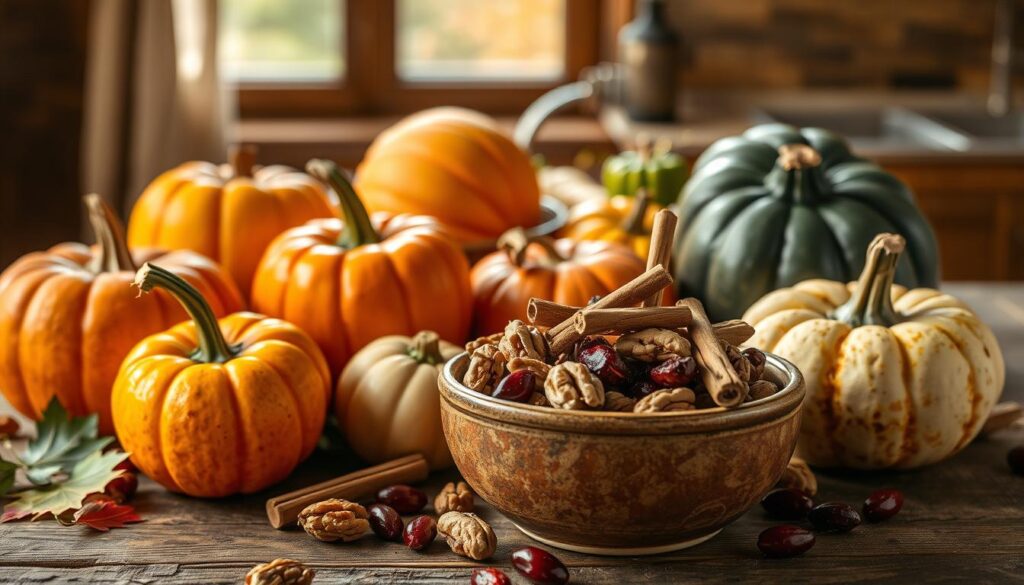As fall arrives, it’s time to slow down and enjoy the harvest’s flavors. Are you ready to nourish your body and soul with the season’s freshest produce?
Eating with the fall harvest helps you eat more mindfully. You’ll enjoy tasty meals and get the health benefits of healthy eating. Exploring fall’s flavors means cooking with fresh, locally sourced ingredients.
Embracing the fall harvest makes your life more balanced and intentional. Share your favorite seasonal recipes with loved ones. Stay inspired with mindful living tips and fresh ideas from Lumina Hive Magazine.
Understanding the Nutritional Benefits of Fall Produce
Fall brings a variety of delicious and nutritious produce. These foods are packed with nutrients essential for a balanced diet. By adding them to your meals, you nourish your body and support local farmers and the environment.
Seasonal Superfoods to Embrace
Fall is the perfect time for nutrient-rich superfoods like squash, kale, and apples. These foods are not only tasty but also full of vitamins and minerals that boost your health. For example, kale is a vitamin K powerhouse, and apples are full of antioxidants and fiber.
“Eating a variety of colorful foods is key to a healthy diet. The fall season offers a range of vibrant produce that can add both flavor and nutrition to your meals.”
The Importance of Eating Local
Eating local produce is good for your health, the local economy, and the environment. It reduces your carbon footprint and supports sustainable farming. Plus, local produce is fresher and more nutritious because it’s picked at the peak of ripeness.
| Local Produce | Nutritional Benefits | Environmental Impact |
|---|---|---|
| Apples | Rich in antioxidants and fiber | Supports local farmers, reduces transportation emissions |
| Kale | High in vitamins A, C, and K | Promotes sustainable farming practices |
| Squash | Good source of vitamin A and fiber | Encourages local food systems |
Nutritional Advantages of Organic Choices
Choosing organic produce has several nutritional benefits. Organic farming promotes soil health, leading to produce with more nutrients and antioxidants. While the difference may not be huge, opting for organic supports a healthier diet and sustainable farming.
If you find this approach appealing, share it with someone who might be interested. For more mindful living tips and fresh ideas, subscribe to the Lumina Hive Magazine. Join our community in creating a life that feels good, inside and out.
Favorite Fall Ingredients to Incorporate into Your Diet

Fall brings delicious and nutritious ingredients that can make your meals better. You’ll find a variety of produce to add to your daily meals. These foods nourish your body and make your meals tasty.
Seasonal Vegetables: Squash and Kale
Seasonal vegetables are key in fall cooking. Squash adds a comforting flavor to soups, stews, and roasted dishes. It’s full of vitamins A and C, and fiber.
Kale is another favorite, packed with nutrients. Enjoy it in salads, smoothies, or sautéed. It’s full of antioxidants and vitamins, making any meal better.
Fruits to Enjoy: Apples and Pears
Fall is great for enjoying tasty fruits. Apples are perfect for snacking, baking, or salads. They come in many flavors and textures.
Pears are also delicious, great for poaching, baking, or eating fresh. Both apples and pears are full of fiber and antioxidants, making them healthy choices.
Whole Grains: Quinoa and Farro
Whole grains add warmth and nutrition to fall meals. Quinoa is a protein-rich grain for salads, bowls, or sides. It’s gluten-free, perfect for dietary needs.
Farro is another fiber-rich grain for soups, stews, or salads. Both quinoa and farro help keep your diet balanced in fall.
Using these seasonal ingredients in your meals lets you enjoy fall’s flavors while eating healthy. Cooking for yourself or others, these ingredients will inspire tasty, nutritious dishes.
Creative Ways to Prepare Fall Dishes
Embracing the harvest means trying new recipes and cooking methods. These bring out the best in fall’s produce. Our kitchens become warm and nourishing as we enter the cooler months.
You can explore the rich flavors and textures of fall ingredients. This will make your meals more exciting.
Soups and Stews for Comfort and Nutrition
Soups and stews are key in fall cooking. They offer comfort and a nutritious meal in one pot. Start with sautéed onions, garlic, and your choice of protein.
Add fall vegetables like carrots, potatoes, and squash. For a filling soup, use beans, lentils, or quinoa for protein and fiber.
Some key ingredients for soups and stews are:
- Butternut squash for its sweet, nutty flavor
- Kale or spinach for vitamins and antioxidants
- Lean proteins like chicken or turkey for nutrition
As Nourishing Meals author, Karen Haber, says, “A warm, comforting bowl of soup nourishes body and soul.”
Roasting for Flavor and Texture
Roasting brings out the natural flavors of fall vegetables. Toss your chosen vegetables in olive oil, season with salt, pepper, and herbs. Then roast at a high temperature.
This method gives a delicious caramelized exterior and a tender interior.
| Vegetable | Roasting Time | Tips |
|---|---|---|
| Brussels Sprouts | 20-25 minutes | Cut in half, toss with bacon or pancetta for added flavor |
| Carrots | 25-30 minutes | Slice into coins or sticks for even roasting |
| Squash | 30-40 minutes | Peel and cube for a comforting side dish |
Seasonal Salads for Freshness
Fall is also a great time for fresh salads. Mix crisp apples, toasted nuts, and tangy cheeses with mixed greens. This makes a refreshing and healthy salad.
Try adding roasted vegetables like butternut squash or Brussels sprouts. This adds depth and warmth. Remember, variety and mindfulness are key to a balanced diet.
If this article inspired you, share it with someone who needs it. For more mindful living tips and fresh ideas, subscribe to the Lumina Hive Magazine. Let’s create a life that feels good, inside and out.
Meal Planning for a Nutritious Fall
Embracing fall flavors through meal planning can change your eating habits and health. The season’s produce variety inspires new recipes, making healthy eating easier.
Weekly Meal Prep Ideas
Start with a clear plan for meal prep. Spend a few hours on the weekend preparing meals for the week. Make a big batch of seasonal vegetable soup, like squash or kale soup, to reheat all week.
Roasting fall veggies like Brussels sprouts and carrots is another great idea. Use them in salads or main dishes. Cooking proteins like chicken or lentils also helps in making various dishes.
| Meal Prep Idea | Main Ingredients | Benefits |
|---|---|---|
| Seasonal Vegetable Soup | Squash, kale, vegetables | Nourishing, easy to reheat |
| Roasted Vegetables | Brussels sprouts, carrots | Versatile, packed with vitamins |
| Protein Prep | Chicken, lentils | Convenient, high in protein |
Balancing Macros with Seasonal Foods
It’s important to balance your macronutrients for energy and health. Fall’s seasonal foods help achieve this. Pair complex carbs like quinoa with roasted veggies and lean proteins.
Enjoy whole grains like farro and oats in fall. They’re full of fiber and keep you full. Include healthy fats from nuts and seeds in your meals.
Incorporating Snacks into Your Fall Routine
Snacking keeps your energy up all day. Enjoy seasonal fruits like apples and pears. Make your own trail mix with nuts, seeds, and dried fruits for a quick snack.
Try making energy balls with oats, peanut butter, and honey. They’re tasty and nutritious, keeping you energized.
If this article inspired you, share it with someone who needs it. For more mindful living tips and fresh ideas, subscribe to the Lumina Hive Magazine. Let’s create a life that feels good, inside and out.
Tips for Eating Intentionally During Fall
As fall arrives, you can connect more with your food and the world. Eating mindfully is not just about nutrition. It’s about feeding your body and soul.
Practices for Mindful Eating
To eat mindfully, enjoy each bite. Notice the flavors, textures, and smells of your food. Eating with others can also make meals more special. This way, you can build a better relationship with food and feel healthier.
Exploring New Flavors and Recipes
Fall is perfect for trying new recipes and flavors. Use seasonal ingredients like squash, kale, and apples. Look for inspiration in cookbooks, blogs, or by trying new things. This keeps your diet exciting and ensures you get all the nutrients you need.
Building Community Through Meals
Sharing meals with others strengthens bonds and builds connections. Host dinner parties or join potlucks. Or, just make time to eat with loved ones. Sharing food creates a sense of community and belonging, which is key for your emotional health.
If this idea excites you, share it with someone who needs a boost today. For more mindful living tips and fresh ideas, subscribe to the Lumina Hive Magazine and stay updated.
FAQ
What are the benefits of eating seasonally during the fall?
Eating seasonally in the fall has many benefits. It boosts your nutrient intake and supports local farmers. It also helps reduce your environmental impact.
By adding fall produce to your meals, you nourish your body. You get vitamins, minerals, and antioxidants.
How can I incorporate more whole grains into my fall diet?
To add more whole grains to your fall diet, try new recipes. Use quinoa, farro, and other seasonal grains. Make hearty bowls, salads, and soups with the season’s best produce.
What are some mindful eating practices I can adopt during the fall?
For mindful eating in the fall, slow down and enjoy your food. Notice the flavors and textures of seasonal ingredients. Eat with intention and gratitude.
This way, you’ll connect more with your body and the food you eat.
How can I balance my macros with seasonal foods during the fall?
To balance your macros with fall foods, include a variety of protein, healthy fats, and complex carbs. Pair seasonal veggies like squash and kale with lean proteins and whole grains like quinoa and farro.
What are some creative ways to prepare fall dishes?
For creative fall dishes, make soups and stews with seasonal ingredients. Roast veggies to enhance their sweetness. Create seasonal salads with fresh and dried fruits.
Try new recipes and flavors to keep your meals exciting.
How can I make meal planning easier during the fall?
To simplify meal planning in the fall, adopt a weekly meal prep routine. Use leftovers in your meals. Plan meals around seasonal ingredients.
Make a grocery list to stay organized and focused.







